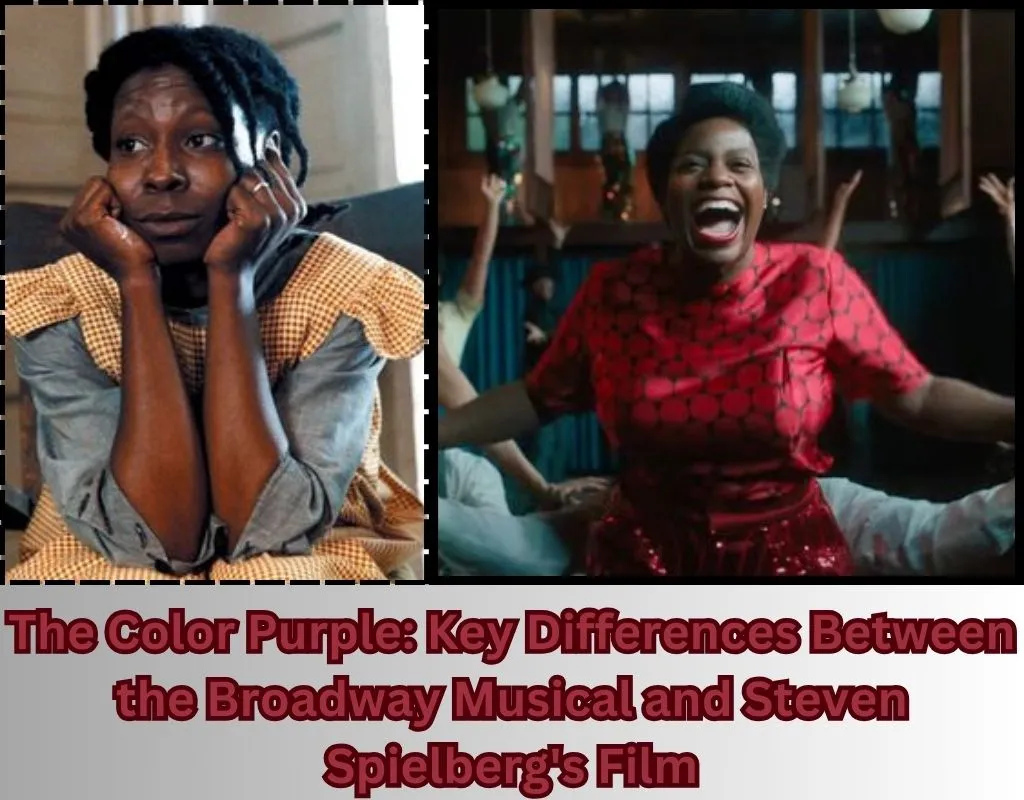The Color Purple: Key Differences Between the Broadway Musical and Steven Spielberg’s Film Adaptation: Each era seems to have its rendition of “The Color Purple.”
This enduring narrative traces the journey of Celie, a Black woman navigating trauma, discovering love, and embracing forgiveness. In 1985, Steven Spielberg helmed the film adaptation featuring Whoopi Goldberg, based on Alice Walker’s 1982 novel. A Broadway rendition debuted in 2005 and saw a revival in 2015, starring Cynthia Erivo.
Now, the newest adaptation is a cinematic musical version of “The Color Purple,” with “American Idol” victor Fantasia Barrino taking on the role of Celie. However, this film doesn’t faithfully mirror the stage production, which was predominantly sung. Interestingly, the movie omits nearly twenty Broadway songs, opting instead for spoken dialogue or introducing new melodies.

“My goal was never merely to replicate the Broadway production,” director Blitz Bazawule explains. “Instead, we pondered, ‘How can we innovate within this esteemed body of work?'”
Bazawule, alongside screenwriter Marcus Gardley, delves into the significant alterations made from previous iterations.
“The New ‘Color Purple’: Clear Representation of Shug and Celie’s Romance”
Spielberg’s film adaptation faced scrutiny for toning down the intimate moments between Celie and nightclub singer Shug Avery, showcasing only a singular kiss. Gardley addresses this by introducing scenes where they awaken side by side in bed, and Celie (portrayed by Barrino) daydreams about a photo featuring Shug (played by Taraji P. Henson). Additionally, their relationship deepens with a heartfelt kiss following their duet “What About Love?”, a sequence where they envision themselves as Hollywood stars, dancing intimately.
“It portrays a universe where their bond could flourish,” Gardley remarks. “This relationship lies at the heart of the narrative, and my aspiration is for LGBTQ+ viewers to feel genuinely represented and respected.”
“Halle Bailey’s Nettie Introduces a Lighthearted New Song”
The film introduces several fresh songs, among them pieces for young Celie (Phylicia Pearl Mpasi) and her sibling, Nettie (Halle Bailey). “She Be Mine,” absent from the Broadway rendition, unfolds within Celie’s thoughts as she yearns for her children taken from her shortly after birth. Gardley notes, “This song offers insight into her innermost thoughts. She isn’t silent; rather, she finds solace and resilience through her imagination.”
“Keep It Movin’,” penned by Bailey for the film, emerges as an uplifting song the sisters perform just before the looming separation enforced by Celie’s oppressive husband, Mister (Colman Domingo). Gardley comments, “Given the film’s prevailing somber tone, we aimed to inject some light-heartedness. This represents the final moments of unity between the sisters before Nettie’s departure. It underscores the profound bond they share.”
“Miss Celie’s Blues” Revived from the Original Film
“Miss Celie’s Blues” Returns: From Spielberg’s Film to the New Adaptation
“Miss Celie’s Blues” makes a comeback, previously seen in Spielberg’s film but absent from the Broadway musical adaptation. In the initial movie, Shug delivers the song at a juke joint to uplift Celie and emphasize her value. In the recent film rendition, Shug revisits this tune during a parlor gathering, marking Celie’s liberation from Mister.
Quincy Jones, credited for co-writing the song and producing both cinematic adaptations, advocated strongly for the inclusion of the Oscar-nominated track. Gardley mentions, “He believed ‘The Color Purple’ wouldn’t be complete without that song.” Addressing this, one of the tasks at hand was reimagining the song to create a more intimate connection between Celie and Shug.
The 2023 rendition of ‘The Color Purple’ also brings back another iconic scene from Steven Spielberg’s film.
Towards the conclusion of Spielberg’s original film, Shug enters the church belting out “Maybe God Is Tryin’ to Tell You Somethin’,” confronting her distant pastor father with the words, “See, Daddy? Sinners possess souls as well.” Though absent from the Broadway adaptation, Bazawule reintroduces a rendition of this scene in his film, presenting a tender duet of the song between Shug and her father, portrayed by David Alan Grier.
Gardley reflects, “For many, this stands out as the pivotal moment in Spielberg’s movie.” He continues, “I aimed to reincorporate that significant scene, not only as a tribute to its impact but also to underscore Shug’s transformative journey. At its core, this film resonates deeply with themes of forgiveness.”
In the new film adaptation, Mister is portrayed with more depth, moving beyond the confines of a mere one-dimensional villain.
In the new film adaptation, Mister’s journey towards redemption is portrayed with greater complexity. The storyline allocates more time to delve into Mister’s realization and regret over his cruel treatment of Celie. He takes steps to mend his past wrongs by apologizing to her and facilitating the return of Celie’s adult children and Nettie from Africa. While the film doesn’t justify Mister’s behaviors, it strives to explore the motivations behind his previous animosity.
“When we gave him a banjo, it became evident that he harbored unfulfilled dreams,” Bazawule observes. “In moments of intoxication, he laments, ‘I could have been in Shakespeare!’ That encapsulates his essence for me — a series of missed opportunities and regrets. His own pain drives him to inflict pain on others.”
“The rendition of ‘I’m Here’ takes a different approach compared to the Broadway version.”
The musical’s standout song, “I’m Here,” is Celie’s powerful declaration of self-love. In the stage version, the setup differs: Celie, after enduring heartbreak from Shug, starts with the line, “I don’t need you to love me.” However, this particular scene and lyric are omitted in the new film adaptation. Instead, the song emphasizes Celie’s longing for her family’s return home.
“Experiencing betrayal by a lover might set the stage, but I believed Celie’s emotions needed a more profound context,” Bazawule reflects. “For her, nothing resonated deeper than the separation from her sister and children. I viewed that as a more compelling foundation for her emotions.”
Read This Also: Confirming ‘Boys in the Boat’: The Truth About the Team Dynamics in George Clooney’s Story http://vegansalley.com/confirming-boys-in-the-boat-the-truth-about-the-team-dynamics-in-george-clooneys-story/

